JMP Public Help
Create visualizations with your data in JMP and share your analyses using JMP Public. Anyone viewing these posts has the interactive capabilities of JMP to explore your data.
Find out more about these topics:
Register for JMP Public
If you are not signed in to JMP Public, you see only featured posts. Before you can publish posts, you need to register and sign in.
|
1.
|
In a Chrome browser, go to https://public.jmp.com.
|
|
2.
|
At the top right, click Sign in.
|
|
3.
|
If you already have a SAS profile, log on using those credentials, then click Submit.
|
|
4.
|
If you do not have a SAS profile:
|
|
a.
|
Click Register. Complete the form and click Create profile.
|
|
b.
|
Follow the instructions in the email to set your password and activate your profile.
|
|
5.
|
(Optional) To change your profile name or picture, once you are signed in to JMP Public, click your name and select My Profile > Edit.
|
Publish JMP Graphs and Reports as Posts
You can use JMP 15 to publish graphs and reports to JMP Public. Graphs and reports appear in a JMP Public post. Create your graphs and reports in JMP and then click File > Publish. For more details, see Save and Share Reports.
Figure 1.1 JMP Public Post Thumbnails
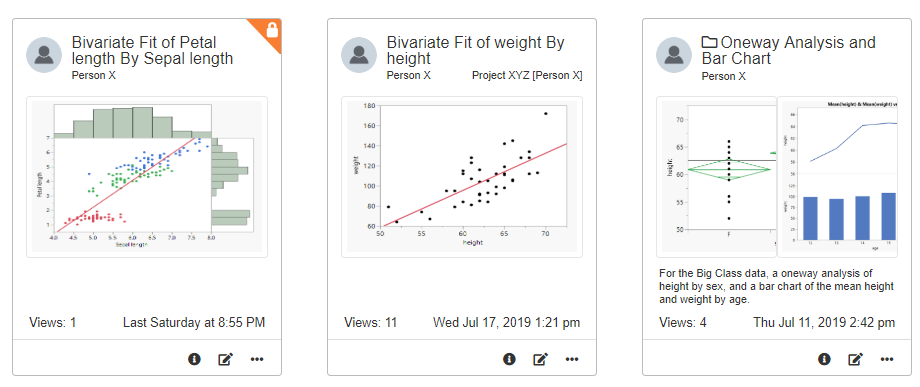
Note: If you choose to make your posts private (shared with Only Me), an orange lock icon appears on the post in JMP Public.
Figure 1.2 Example of a JMP Public Post
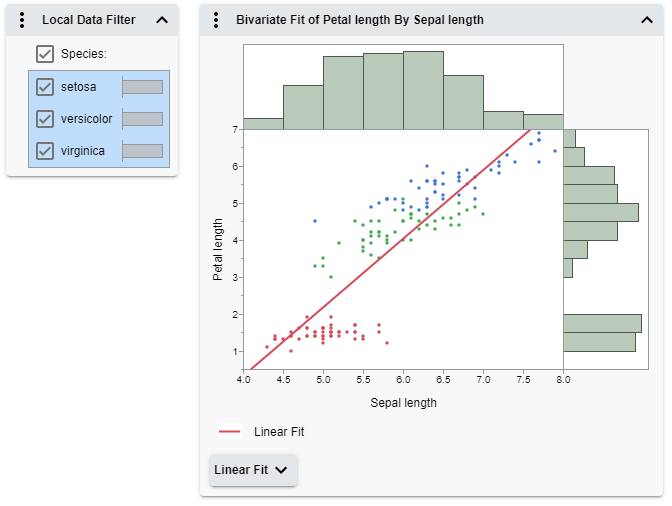
Interact with Posts
Find out what you can do in posts:
Open Posts
Posts appear under My Dashboard and All Posts:
|
•
|
My Dashboard: Contains all of the following types of posts:
|
|
–
|
posts that you have published
|
|
–
|
posts that your followers have published
|
|
–
|
posts published to groups that you are a member of
|
|
•
|
All Posts: Contains everything from My Dashboard and all public posts (that are shared with everyone).
|
Click a post to open it. If there is only one post, it opens directly. If there are several posts, click the one you want to see.
Figure 1.3 Single Post Thumbnail (Left) and Multiple Post Thumbnail (Right)
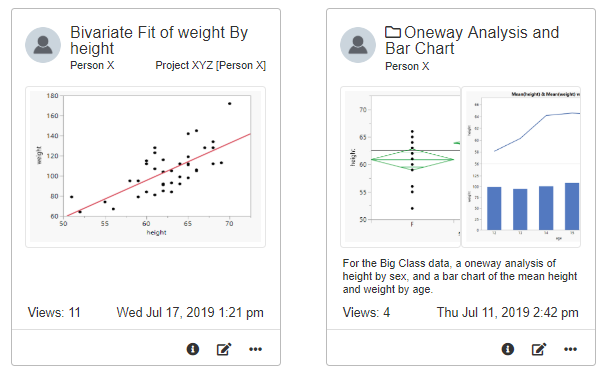
In a graph or a report, point your cursor or tap on a data point or a calculation to see its values or description.
Note: To open or close reports and graphs, click or tap the arrow to the right of the title.
Figure 1.4 See a Data Point’s Values
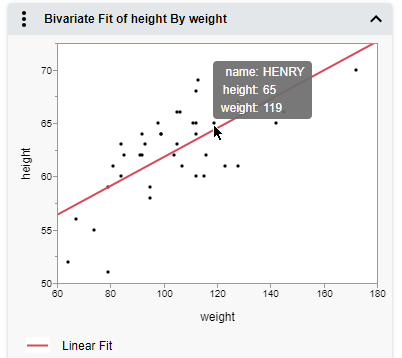
Figure 1.5 See an Explanation of a P-Value Calculation

Select Data
How you select data in a graph (points, bars, and so on) depends on whether you are on a computer or a mobile device. The default mode is to select a single data point. If you want to select multiple data points:
|
•
|
On a computer, press Shift then select the data points.
|
|
•
|
On a mobile device, tap the multiple selection icon and then select the data points.
|
|
On a computer
|
On a mobile device
|
|
|---|---|---|
|
Select or deselect a single data point
|
Click a data point.
|
Tap
 then tap a data point. then tap a data point. |
|
Select or deselect multiple data points
|
Hold down the Shift key and click multiple data points.
|
Tap
 then tap multiple data points. then tap multiple data points. |
|
Identify a single data point
|
Point to a single data point.
|
Tap
 then tap a data point. then tap a data point. |
|
Select data points by brushing
|
Click and drag a rectangle over data points. Click and drag in the center to move the rectangle, or drag the corners to resize it.
|
Tap
 then draw a rectangle over the data points. Drag the center to move the rectangle, or drag the corners to resize it. then draw a rectangle over the data points. Drag the center to move the rectangle, or drag the corners to resize it. |
See Linked Data
If your JMP report contains multiple graphs, data in all graphs are linked. So if you select data, it is highlighted in all associated graphs.
Figure 1.6 Select Data in Linked Graphs
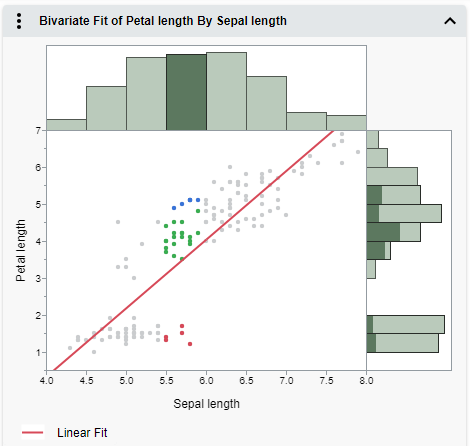
In this example, a histogram bar in the top graph is selected. The corresponding rows are highlighted in the scatterplot and in the marginal histogram.
Exclude and Hide Data
Once you have selected data, you can exclude it from report calculations and hide it in graphs. Reports and graphs automatically update.
Figure 1.7 Report Menu Options
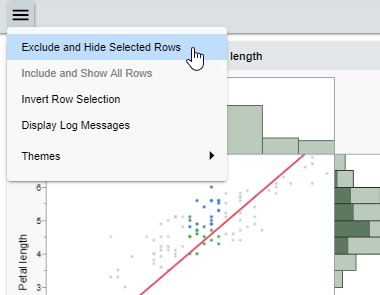
To exclude and hide data, use the options in the Report menu:
Note: If the report contains a Local Data Filter, most of these options do not appear, since you use the Local Data Filter instead.
|
•
|
Exclude and Hide Selected Rows: Excludes and hides selected data.
|
|
•
|
Include and Show All Rows: Includes and shows any excluded or hidden data.
|
|
•
|
Invert Row Selection: Changes the current selection to the deselected data.
|
The Report menu also contains these options:
|
•
|
Display Log Messages: Shows messages from the server and any unexpected conditions from the client.
|
|
•
|
Themes: Changes the page appearance. See Change the Theme.
|
Filter Data
If the original JMP report included a Local Data Filter, you can use it to focus on specific data and see the impact on graphs and reports.
Figure 1.8 Filter Data in Graphs
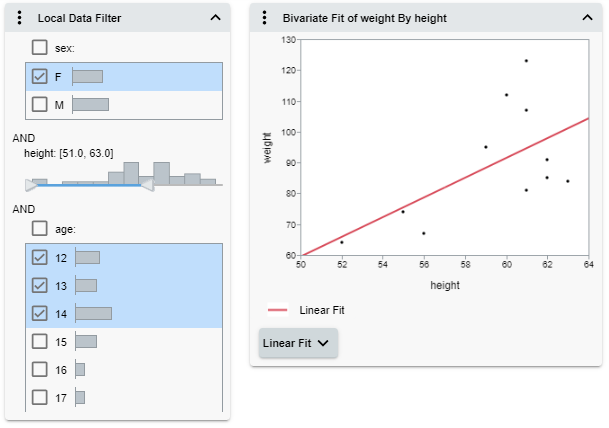
In this example, the filter choices are showing only females between 51 and 63 inches tall who are between the ages of 12 and 14.
Local Data Filter Options
Conditional Filtering
Limits the options in the Local Data Filter by condition. For more information, see Using JMP.
Note: This option does not appear if there is more than one OR group, or if the columns are not hierarchical.
Invert filter
Inverts currently selected filters.
Select filtered rows in graphs
Selects all filtered rows in graphs.
Show filtered rows in graphs
Shows all filtered rows in graphs.
Include filtered rows in calculations
Only filtered rows are included in report calculations.
Modify Graphs
Use the options in the  menu to customize graph elements.
menu to customize graph elements.
 menu to customize graph elements.
menu to customize graph elements.
Figure 1.9 Change the Marker Size
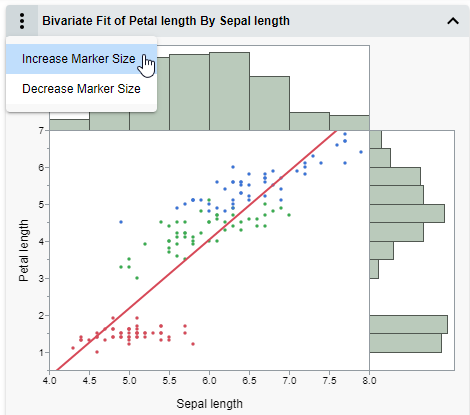
The options in this menu can vary depending on the type of graph or JMP platform. For example:
|
•
|
In scatterplots and histograms, you can change the marker size.
|
|
•
|
In profilers, you can reset the profiler to its original state, or re-scale the vertical axis to include the response.
|
|
•
|
In data filters, you can choose how you want to filter data.
|
|
•
|
In bubble plots, you can change the appearance of the bubbles.
|
Change the Theme
To change the page appearance, click  > Themes.
> Themes.
 > Themes.
> Themes.
Figure 1.10 Change the Page Theme
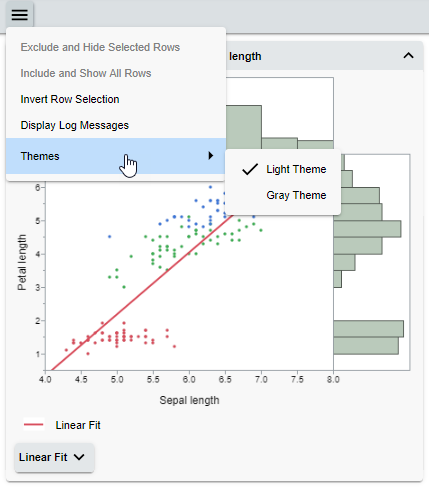
Edit Posts or See Post Details
On a post thumbnail, or from a post, you can do the following:
|
•
|
Click
|
|
•
|
Click
|
Figure 1.11 Edit a Post’s Details
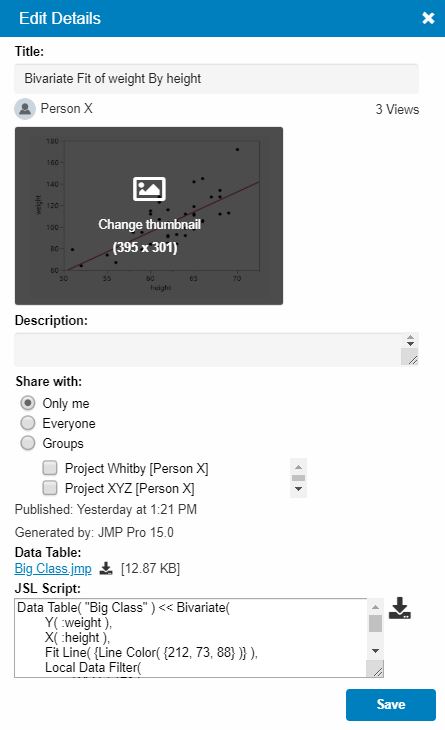
You can download the associated data table(s) and the JSL script that re-creates the post.
Tip: If you want to add a link to a website in the report description, you can use these HTML tags: <a href= "target">, <b>, <em>, <i>, <strong>, and <u>.
Delete Posts
On a post thumbnail or from a post, click  > Delete to delete a post that you created.
> Delete to delete a post that you created.
Figure 1.12 Delete a Post
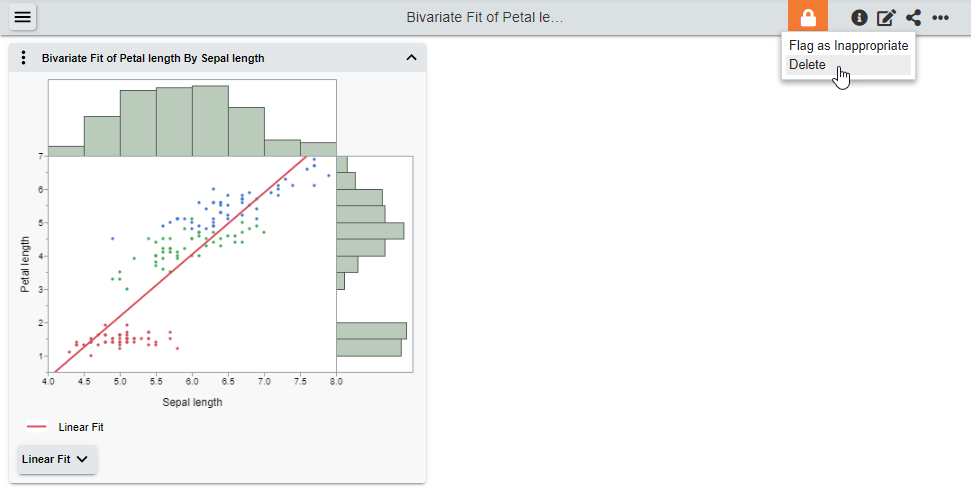
Share Posts
From a post, click  to share the post. You can share a post in any of these ways:
to share the post. You can share a post in any of these ways:
|
•
|
on social media: Facebook, Twitter, LinkedIn
|
|
•
|
email a link
|
|
•
|
copy a link
|
|
•
|
copy embedded HTML code (for a web page)
|
Figure 1.13 Sharing Options
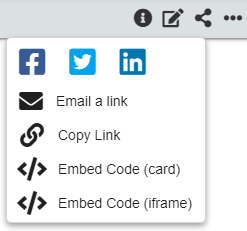
Note: If you are sharing your own post, you might not see all of these options if the sharing setting is restricted to only you. To change sharing settings, click  and share with everyone or with a group.
and share with everyone or with a group.
Flag Posts or Users
If you think a post or user profile contains inappropriate content, you can flag it to the administrator:
|
•
|
To flag a post: On a post thumbnail or from a post, click
|
|
•
|
To flag a user profile: From a user profile, click
 > Report User. > Report User. |
Here is what happens when a post or user profile is flagged:
|
1.
|
JMP administrators determine whether the post or user profile should be hidden or removed.
|
|
2.
|
If the post is hidden or removed, the owner of the flagged post or the flagged user is notified (if they have not turned off notifications for flags). For hidden posts, the owner can attempt to fix the problem and let the administrator know. The administrator can then reinstate the post if they approve.
|
Manage Notifications
In JMP Public, you are notified when any of these things happen:
|
•
|
someone new starts following you
|
|
•
|
someone requests to join a closed group that you are an administrator of
|
|
•
|
someone flags a post that you created or flags your user profile
|
|
•
|
an administrator deletes one of your posts
|
To see your notifications, click Notifications  . From here, you can do the following actions:
. From here, you can do the following actions:
|
•
|
Click a notification to take you to its source. For example, if someone started following you, their user profile opens. If you receive a request to join a closed group, the group opens.
|
|
•
|
Click See All to see all notifications in a larger window. From here, you can do the following:
|
|
–
|
Click Mark All as Read to turn them from gray (not read) to white (read) and remove the notification number flag.
|
|
–
|
Click Clear All to clear all notifications.
|
|
–
|
Click
|
|
–
|
Click Settings to manage your notifications. See Manage Notification Settings.
|
Manage Notification Settings
On the Notification Settings page, you can choose which types of notifications you want to receive and how often you want to get email notifications.
|
•
|
Stop receiving a notification of a certain type: Under On JMP Public, click Off.
|
|
•
|
Change how often you get email notifications: Under Email, choose a time period.
|
Figure 1.14 JMP Public Notification Settings

Search for People, Posts, or Groups
You can search JMP Public in these ways:
|
•
|
To search all of JMP Public, enter a name or keyword in the search box at top right.
|
|
•
|
To filter posts on the Home pages, enter text in the Find User, Find Group, and Find (keywords in posts) boxes. See Filter Your Search.
|
Figure 1.15 Search Options (JMP Live and JMP Public)

Filter Your Search
To use filters, depending on where you want to search, go to Home > My Dashboard or All Posts.
|
•
|
To find all posts from a user or group, enter a user name or group name in the Find User or Find Group box. Suggestions appear as you type.
|
|
•
|
To search by a keyword in a post title, enter a word into the Find box.
|
|
•
|
You can refine your search by restricting the date or by limiting it to a certain group.
|
|
•
|
To clear your search, click the x next to a user name, or clear other fields by clicking Clear All.
|
Follow Someone
If you follow someone, their posts appear on your Dashboard.
Figure 1.16 Follow Someone
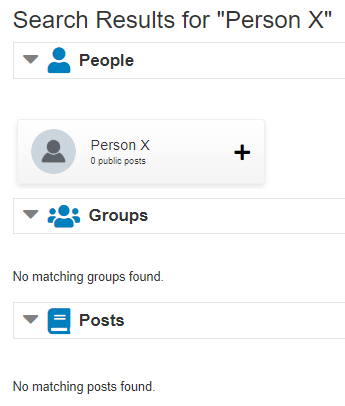
To follow someone, do one of these actions:
|
•
|
Next to their name in the search results, click
|
|
•
|
Click a person’s name to go to their user profile, and then click Follow.
|
Edit Your Profile
|
1.
|
At the top right, click your name > My Profile.
|
|
2.
|
Click Edit.
|
|
3.
|
Change your picture, display name, or password.
|
|
4.
|
Click Save.
|
JMP Public Groups
In JMP Public, only JMP administrators can create groups and add members. However, you can join any open groups and request to join any closed groups.
|
•
|
To see only groups that you have been added to, click Groups > My Groups.
|
|
•
|
To see all groups, click Groups > All Groups.
|
In your groups, you can do the following:
|
•
|
post to the group
|
|
•
|
see all posts and members in the group
|
|
•
|
leave the group
|